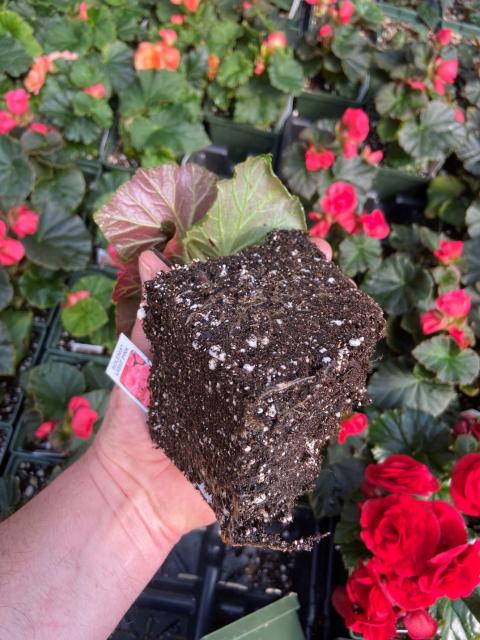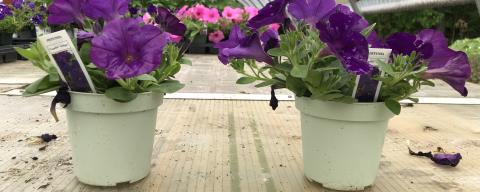Introduction
Two major considerations for production of plants in containers, pots, flats, etc. are the potting soil and fertilizer to be used. This fact sheet will look at some options for these and will explain some considerations when using organic fertilizers in container production.
Soil vs. Potting Media
Soil is a mixture of very small pieces of rock of varying size (sand, silt and clay) and biological material (plants, animals or microbes) at different stages of life or decay. Air and water are also very important components of soil. Most natural soils are poor for growing plants when removed from the ground and placed into pots or containers; they tend to be too “heavy”; slow draining with inadequate air space. As such, we use potting soils, or a “potting medium” (plural: “potting media”) when growing plants in containers, flats, pots, cell packs, etc. When these contain no soil at all, they are sometimes called “soilless potting media”. It is common to start a plant indoors in a container using potting medium and later transplant it outside into true soil in a garden.
Potting media are usually a mixture of a few different components. Common components include peat moss, shredded bark, coir (fiber and pith from coconut hulls), wood fiber, perlite, vermiculite, rice hulls, compost, and others. Some potting media do add in some actual soil (“field soil”). It was common practice decades ago in the commercial greenhouse industry to mix potting media using field soil. This is almost never done today, as soilless potting media result in lower disease pressure, provide better drainage and are lighter to transport. Today, we can select from many commercially available soilless potting media or mix our own from available components.

Plant nutrients and fertilizer
It is important to understand that although plants create their own food from carbon dioxide, water and sunlight, they require about 13 different nutrients in varying amounts to grow and function properly. These nutrients are elements like nitrogen, potassium, calcium, magnesium, iron and others. In nature these nutrients are supplied in the soil. We need to account for these nutrients when growing plants in containers, whether they are provided by the components of the medium or added in the form of fertilizers.
Definitions
The word organic has come to mean some very different things. For the sake of this fact sheet, the word “organic” means naturally occurring. An “organic fertilizer” is a source of plant nutrients which comes from some naturally derived source and is likely approved for production of USDA Organic Certified crops. An “organic molecule” is one that is carbon based; these make up, come from, or interact with living organisms.
Fertilizer types
Conventional water-soluble fertilizers are meant to be dissolved in water and applied when watering. These fertilizers contain many (but often not all) of the 13 nutrients required by plants. (Many conventional water-soluble fertilizers do not contain calcium or magnesium; these are supplied by a small amount of limestone mixed into the potting medium by the potting medium manufacturer.) Some trade names of these products are Miracle Gro, Jack’s and Vigoro. These are not approved for use in the production of USDA Organic Certified crops.
Controlled release fertilizers (CRF) are little balls of conventional water-soluble fertilizers that have been covered with a coating designed to slowly release the fertilizer from within. We can add these to potting media. Some trade names of these products are Osmocote and Nutricote. Several commercially available potting media have controlled release fertilizer already mixed in. These bags often claim something like “Feeds up to 6 Months” or “Continuously Feeds”. Potting media containing controlled release fertilizers are manufactured by Miracle Gro, Vigoro and others. These are not approved for use in the production of USDA Organic Certified crops.
Conventional granular fertilizers (like 10-10-10) intended for outdoor garden use are not suitable for use in containerized production. Make sure that the label on the fertilizer you buy has use rates for container production.
Solid organic fertilizers may be individual ingredients like bonemeal, cottonseed meal, manures, greensand, etc., or they may be preformulated from multiple sources. Some examples of these products are Sustane or Plant-Tone. These may be approved for use in the production of USDA Organic Certified crops.
Liquid organic fertilizers are applied like a conventional water-soluble fertilizer; mixed with water and applied during watering. These are often products such as fish emulsion, liquid kelp or a pre-formulated product like Fox Farm or Nature’s Source. These may be approved for use in the production of USDA Organic Certified crops.

Special considerations for organic fertilizers in potting media
Did you know? Plants can't use the molecules in organic fertilizers until broken down by microbes in the soil.
When we examine fertilizers approved for production of USDA Organic Certified crops at the molecular level, we see that most are made up of organic molecules such as fats, proteins and carbohydrates. Although submicroscopic, these molecules are quite large compared to others. It’s important to note that for the most part plants can’t take up or use these large molecules. Plant roots have molecular gates that allow the plant to take in tiny little charged atoms and molecules, called ions. The 13 nutrients needed for plant growth are in the ion form: nitrate, potassium, phosphate, etc.
In healthy soil, organic molecules are broken down into ions by bacteria and fungi living in the soil. These ions are then able to be used by the plant. This is a driving principle behind Organic Certified agriculture: “feed the soil, not the plant”. By contrast, when we use conventional, inorganic fertilizers that dissolve in water, the ions from the fertilizer are directly available to the plant for uptake through those tiny gates in the plant’s root hairs. This is a driving principle behind hydroponic (soilless) production: “Provide the plant exactly the nutrients it needs without using soil.”
We can see the challenge this creates for growers who want to use organic fertilizers while using a soilless potting medium for the benefits (better draining, less disease pressure, better retention of fertilizer) it provides. While the microbes which decompose organic molecules exist all around us, in a soilless potting medium it may take them some time to build up a population dense and diverse enough to make organic fertilizers available at a rate useful for plant growth. For something being grown as a transplant to be put out into a garden with a very short crop time, this delay can result in stunted, nutrient deficient plants not ready to go out when scheduled.
Did you know? Adding some quality compost to a potting medium can increase the availability of organic fertilizers.
In order to use organic fertilizers to grow short-term containerized crops, we need to use a potting medium conducive to a healthy microbial community. We can do this by adding some quality compost to our potting medium. Compost that is good quality does not have a strong smell or feel warm or slimy to the touch. When being used to make a potting medium more microbially active, 10% compost should be sufficient. Some potting media intended for production of Organic Certified crops are sold with a certain amount of compost already added, such as from Vermont Compost or Coast of Maine. These media may or may not have organic fertilizers already mixed in. Compost alone will likely not be sufficient as a sole source of nutrients for growing plants in containers; a complete fertilizer is still required. To learn more about purchasing compost: https://extension.unh.edu/resource/purchasing-compost-tip-sheet
Mycorrhizae and Bio stimulants in potting media
Many commercial potting media now contain mycorrhizae. These are microscopic fungi that colonize the roots of the plant and make nutrients more available to plant roots. They may even be sending signals to tell the root which way to grow to find nutrients. Other potting media contain “biostimulants”. These may be bacteria, fungi, plant-based acids, etc. intended to provide various benefits such as protecting against bad fungi or bacteria, slowing decomposition of the potting medium, increasing plant growth or stimulating plant defenses. It’s important to note that mycorrhizae and biostimulants premixed into commercial potting media do not break down organic fertilizers. Even if these are included in a potting medium, compost is still needed to get the greatest benefit from organic fertilizers.
Summary: A few options commonly used to grow plants successfully in containers:
1. Use a standard potting medium with conventional water-soluble fertilizer dissolved in water and applied when irrigating the plant.
Pro: These fertilizers and potting media are relatively inexpensive. Plants rapidly use these fertilizers so they can quickly remedy plant nutrition problems. Easy to use “out of the bag”.
Con: Not approved for production of Organic Certified crops. Can burn plants if mixed incorrectly.
2. Use a standard potting medium with a Controlled Release Fertilizer mixed in, either by yourself or from the manufacturer.
Pro: easy to use “out of the bag”. Little to no fertilizer mixing required after initial planting.
Con: more costly than water soluble fertilizers. Works slowly; cannot be used for a rapid fix on a nutrient deficient plant. Not approved for production of Organic Certified crops.
3. Use a potting medium which contains compost with a solid organic fertilizer mixed into the soil prior to filling and planting.
Pro: slow release may mean not needing to add fertilizer later in crop cycle.
Con: more costly, initial mixing can be difficult, products may be harder to find. Heavier. Fertilizer release rate may be dependent on moisture and temperature.
4. Use a potting medium which contains compost with a liquid organic fertilizer mixed in water and applied when the plant is irrigated.
Pro: available to the plant more readily than solid organic fertilizers.
Con: more costly. May be smelly.
Growing containerized plants in potting medium with fertilizers is a great way to enjoy plants indoors, to maximize the use of patios, decks and other small spaces, and to start young plants to be transplanted into the garden. For greatest success, take a moment to make sure that the potting medium you select or make will be compatible with the fertilizer you select.
For more information on growing plants in containers with potting media, see the UNH Extension Fact Sheet Starting Plants from Seed.
- Inclusion or exclusion of commercial names, logos, products or services does not equate or imply endorsement by UNH Cooperative Extension or the University of New Hampshire. -
Do you love learning about stuff like this?
SUBSCRIBE TO Granite State Gardening newsletter
Got questions? The UNH Extension Yard and Garden Infoline offers practical help finding answers for your yard and garden questions.
Call toll free at 1-877-398-4769, Monday to Friday, 9 a.m. to 2 p.m., or fill out webform.

